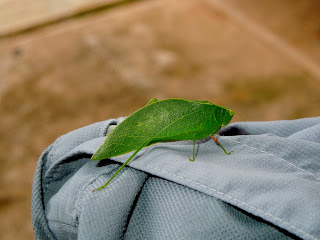 |
| Linnae and I at Swearing-In Ceremony |
Well, it’s been a couple of weeks since I last updated this
blog. When last you heard from me, technical training was coming to a close and
we were getting ready to leave Woodford for Kingston (or “town” as Jamaicans
refer to it). Reconvening in “town” was a fun experience because we got to meet
up with the Trainees from the Education and Youth as Promise sectors and learn
what their previous five weeks had been like. It was a pretty exciting two
days. The first day we had a bit of training and then our sites were revealed
to us in the afternoon. Our Program Manager had been developing the sites over
the last several months; making sure that partner organizations were
appropriate for each volunteer and that housing was safe and adequate. He used
Google Earth in such a way that for each trainee, the view would start as a
zoomed out satellite image of Jamaica and then it would zoom in to the
community where each person would serve. It was then we learned our home and
work site for the next two years would be Bluefields in Westmoreland parish.
 |
| Sunset over Bluefields Bay |
In our opinion, being placed in Bluefields was like hitting
the Super Lotto Jackpot of Peace Corps locations. Bluefields is a sleepy
bayside community of fishermen and farmers where Linnae and I are living in
rustic conditions, but have the blessings of wonderful people to work with and
turquoise waters to relax in. More about that later. The other information we
learned at the site revealing ceremony is who we will be working with. My
partner organization is the Westmoreland Organic Farmers Specially Authorized
Society (WOFSAS). The organization used to be simply named Bluefields Organic
Farmers Group, but because of the type of NGO status they wanted to qualify for
and some unfortunate naming policies, WOFSAS is their new unwieldy name. Linnae
has been assigned to the Bluefields Bay Fishermen’s Friendly Society (BBFFS). I
will commit a blog post to our duties later.
 |
| Our little cabin |
OK, let me backtrack a little. So, we learned about our site
locations that first day back in Kingston. The next day, we all got to meet our
counterparts. For Linnae and I that meant meeting the presidents of WOFSAS
(Brian) and BBFFS (Wolde). The morning of that second day was spent with
introductions and small talk with our counterparts followed by lunch and then
loading all of our luggage into a van and heading west across the island for
site orientation week. When we finally arrived at our yard (in Jamaica, yard is
a term that refers to the area that a cluster of houses are located, often an
extended family situation), I breathed a sigh of relief for a few reasons: 1) I
knew we were done hauling our luggage around for a long time, 2) I could tell
immediately that there was a lot of character in our yard and community, 3) our
living conditions are as rustic as the average Peace Corps Volunteer, negating
the “Posh Corps” stereotype Jamaica gets. Linnae and I live in a 400 sq ft wooden
cabin that relies on catching rain water to fill a tank that provides our
bathing, dishwashing, and toilet water. I will admit we are a little spoiled by
the fact that the previous Volunteer was able to acquire free internet from
some high-end villas down on the bay. We happen to be in line with the signal
that is broadcast to their office and guesthouses. I will soon commit a blog
post to describing our living situation and talk about our new host-mother
“Bumpy” and the extended family in the yard.
 |
| Side view of cabin |
 |
| Fixing lunch with Kevin |
 |
| Fishing beach where Linnae and I work |
Site orientation week mainly consisted of getting to know
community members, unpacking, and being driven around to schools and other
areas of interest. We were in Bluefields from Tuesday to Saturday morning, when
we all headed back to Kingston via public transportation. After about five
hours of travel we finally arrived at the hotel, but we were heartened by the
fact that we only had six days before swearing in, becoming official, and
starting the next phase of our adventure. There isn’t much to report on about
that week, except of course for the big swearing in ceremony at the U.S.
Ambassador’s residence.
 |
| Lion Fish, a delicious invasive species |
This year marks the 50th anniversary of Peace
Corps in Jamaica and also the 50th anniversary of Jamaican
independence from Britain. Therefore, our ceremony was a big “to do”. All in
all there were over 250 guests including a former Prime Minister, the current
Governor General, high-level Jamaican politicians, the U.S. Ambassador, the
media (we made the evening news), and more. The ceremony consisted of remarks
from the Jamaica Governor General and Peace Corps officials, a musical
performance, the administration of the oath that transferred our status from
Trainee to Volunteer, brief remarks from myself and two other Volunteers
nominated to speak on behalf of their sector, and a ceremonial cutting of the
50th Anniversary cake. It was a hot morning in Town, so I was glad to
climb back into Linnae’s supervisor’s van and cruise back to our seaside home
away from home.
 |
| Fisherman with a stringer of snapper |
I realize I have condensed two weeks of hustle and bustle
into just over 900 words. Now that we are settled in, I will try to blog a
little more frequently or at least with more specificity so as to better share
our experiences in the “real” Jamaica. Until next time, Walk Good.










